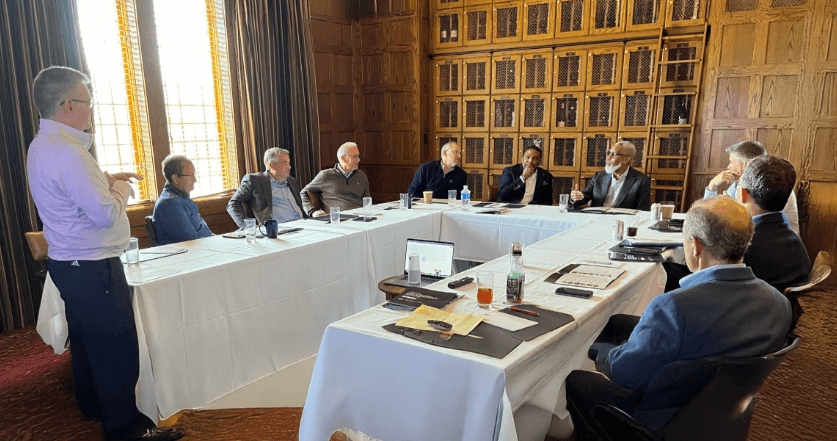

Beyond Budget Cuts:
Procurement Perspectives Across Industries from Healthcare to Retail
Insights from the LogicSource Cross-Industry Spend Management Exchange
LogicSource recently brought together a group of senior leaders for an intimate executive exchange at Kinloch Golf Club in Virginia. The idea behind the meeting was simple but powerful: to create a space where both healthcare and corporate executives could have a real conversation about cost transformation, far from the usual industry jargon and corporate silos. The setting was beautiful, but the discussion was anything but recreational. As the national economic pressure evolves and traditional cost management strategies are wearing thin, this gathering of minds aimed to inspire a different kind of dialog among executive leaders – and problem-solving strategies urgently needed.
The day kicked off with Bill Santulli, former COO of Advocate Aurora, offering a big-picture yet visionary perspective on what’s driving change in healthcare today. He walked through three major forces reshaping the industry: demographic shifts, emerging technology, and the increasing role of private capital.
Bill shared that America is aging rapidly, and the effects are already showing. By 2029, even the youngest Baby Boomers will be eligible for Medicare. Healthcare utilization surges after age 65 and even more dramatically after 75, but reimbursement systems like Medicare and Medicaid are not keeping up. The financial pressure is growing with fewer commercially insured patients who can absorb costs.
The last two years of life typically account for more than one-third of a person’s total lifetime healthcare spending. Much of that cost comes from individuals managing multiple chronic conditions. About 85 percent of Americans have at least one, and 15 percent have three or more. These patients use a disproportionate share of services, yet many do not have the financial or logistical resources to manage today’s complex care demands.
Add in a shrinking labor pool that cannot meet the growing demand for healthcare workers, and the system cannot keep operating as it has; the math and the workforce do not work.
Then there’s technology, particularly artificial intelligence (AI), which represents an unprecedented opportunity that healthcare has been slow to embrace. Bill emphasized how generative AI could support everything from clinical documentation and revenue cycle management (RCM) and drug discovery to imaging, diagnostics, and personalized care planning. However, those opportunities remain out of reach without intentional integration across vendors and health systems.
On the financial side, private equity and venture capital continue to flow into the sector at a remarkable pace.
Nearly 40 percent of hospitals are operating in the red, and external investment is pushing healthcare executives to adopt new levels of operational rigor. As Bill dutifully explained, “We’re saving lives, but that doesn’t mean we’re above basic business discipline.”
Following Bill’s presentation, the conversation shifted into a lively panel featuring Tim Johnson, CFO of Victoria’s Secret, Eva Borrato, CFO of Bath & Body Works, and Steve Downey, Chief Supply Chain Officer at Cleveland Clinic. The goal was to explore how different industries think about cost management and supply chain transformation and what healthcare can learn from other industries’ best practices.
Eva spoke candidly about Bath & Body Works’ journey during and after COVID. At the height of the pandemic, their revenues jumped nearly 50 percent. However, when demand eventually normalized, the company had to find a way to drive efficiencies without cutting corners on brand or customer experience. She emphasized that the focus was never merely on reducing costs but on transformation. LogicSource helped her team unlock $200 million in savings and, more importantly, identify outdated vendor relationships and out-of-market payment terms that had gone previously unnoticed. Similarly, Tim offered a fresh perspective on the role of finance leaders, challenging the old stereotype of the CFO as the stakeholder who always says “no.” He challenged attendees to think about how the role of the CFO should be about enabling progress, not stifling it.
Herb Buchanan, formerly with UChicago Medicine, attended the session and contributed a sobering and empathetic view of the healthcare system. He reflected on how often clinical leaders like those in nursing or radiology see the CFO as an obstacle rather than a partner. “They won’t let me get the supplies I need,” is a common refrain from clinical teams, underscoring the cultural divide between finance and operations in many health systems.
Tom Lubotsky of AllinaHealth, who was also in attendance, offered his thoughts about the importance of recognizing when external expertise is needed. He emphasized that supply chain teams are often viewed – both internally and externally – through a lens that is too narrow. “These are process and efficiency experts,” he shared, “and they can set up systems better than many realize.” His takeaway was that humility and partnership go a long way in making meaningful, operational progress, which means engaging creative problem solvers in unconventional ways.
Later in the discussion, Eva highlighted the importance of leadership alignment, especially from the CFO. When the CFO leads a cost transformation effort, it brings alignment from the top and helps build credibility across the organization. She said that credibility makes it easier to build momentum and drive results and has cultural implications beyond the initiative that drives value.
Steve Downey shared how there were still gaps in visibility even at Cleveland Clinic, which has a relatively mature supply chain. Steve offered, “We knew how to build an elevator, but did we know how much it should really cost? In which market? There was a gap.” LogicSource helped fill those knowledge gaps with real market benchmarks and visibility, providing data they couldn’t achieve with their own market frequency
The conversation eventually evolved into discussing the role of group purchasing organizations, or GPOs. There was consensus that GPOs can be helpful, particularly for direct supplies and devices. However, many health systems are turning to them for indirect spending support too, which resides outside their core strength. Further, their contract coverage is not as complete and may not meet the bespoke needs of an organization’s indirect category spending. Better options are needed, particularly ones with deeper domains (marketing, IT, facilities, finance, corporate services) and cross-industry experience. The overall sentiment was that GPOs serve a vital purpose but aren’t always the best answer in all cases.
As the discussion shifted to strategic partnerships, Bill challenged attendees to reflect on healthcare’s traditional resistance to outsourcing and reconsider ways to drive action. He noted that many nonprofit systems hide behind their tax status as a reason not to change when real-world outcomes suggest that managing it alone hasn’t delivered the results patients and providers deserve. He urged leaders to stop asking, “Should we?” and instead start asking, “How do we get it done?” Tim expanded on the challenge by offering a memorable analogy. “If a healthcare foundation received a $60 million donation, they’d never turn it down. So why is there so much hesitation around capturing $60 million in non-clinical savings that don’t affect patient care?”.
Throughout the day, retail and healthcare had more parallels than differences. Both sectors operate with tight margins. Both are deeply mission-driven, whether it’s brand protection or patient care. And both are facing growing pressure to do more with less. But there were also clear differences – albeit mostly historical. Retail makes faster decisions, consults benchmarks outside its own industry, and embraces outsourcing more strategically. In healthcare, decision-making often stalls, internal comparison is the norm, and the overarching assumption remains that “we’re different.” The industry’s “we’re different” mindset is wasting time and resources. In healthcare, this attitude often leads to higher costs, ironically reinforcing the belief that each organization is unique. Retail leaders see cost transformation as a growth strategy.
Healthcare still tends to treat it as a defensive move.
Above all, panelists and attendees shared an undeniable, collective sense of urgency. Healthcare is reaching a tipping point. Demographics, reimbursement models, labor constraints, and rising costs are converging, making it impossible to solve today’s challenges with yesterday’s playbook. The executives who gathered at Kinloch didn’t just share ideas. They challenged their peers in attendance and back home to reframe how we think about cost, be willing to look outside the industry, and tap the full value of non-clinical levers.
While healthcare’s mission remains somewhat unique, its operational challenges are not.
Looking for an external partner to help with your indirect sourcing and procurement needs?
Get in touch with us, and we’ll walk you through the process.







